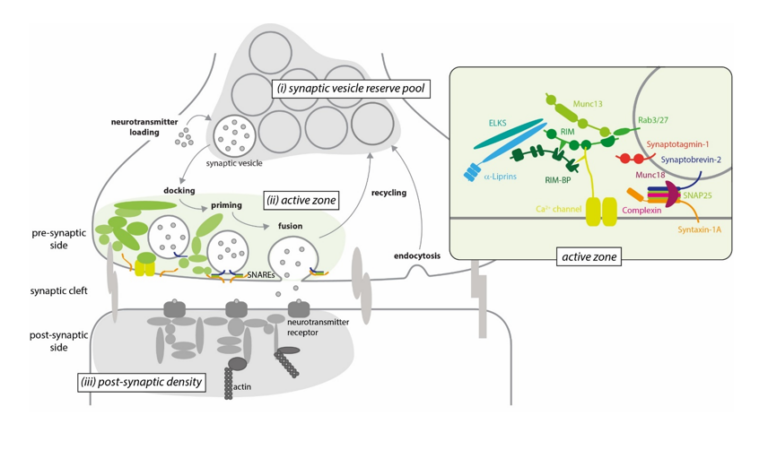Signal transmission between neurons takes place at specifically designed contact sites called synapses. Successful transmission of the signal strongly relies on the organisation of the synapse into different functional compartments including the synaptic vesicle reserve pool and the active zone in the pre-synaptic neuron as well as the post-synaptic density in the post-synaptic neuron. Importantly, these compartments are not fully enclosed by a phospholipid membrane; they rather represent membrane-less compartments that assemble from a set of specific proteins. In the active zone, synaptic vesicles are tethered to the plasma membrane and maintained in an activated state until an action potential arrives. The active zone assembles from a set of scaffold proteins including RIM, RIM-BP, Munc-13, ELKS and a-Liprins, some of which were recently described to form condensates that recruit and cluster voltage-gated Ca2+-channels or even synaptic vesicles. However, quantitative and mechanistic insights into the formation and the dynamics of synaptic condensates in general, and the active zone in particular, are missing.
Here, we propose to unravel the architecture of the active zone and to study the phase behaviour of specific scaffold proteins, therefore, highlighting their multivalent interactions. Specifically, by combining experimental and computational approaches, we will generate a coarse-grained model of the active zone and establish phase-diagrams of specific sets of proteins describing their contribution to condensate formation. We will then integrate functional proteins into this model and explore the impact of phase separation on vesicle recruitment. The results of this research proposal will pave the way for studying synaptic vesicle shuttling in the pre-synapse and for understanding how this process is accomplished by dynamic protein assemblies. In summary, we will contribute to the understanding of compartmentalization in the synapse and, in a larger context, the functional role of multivalent interactions in well-orchestrated processes such as signal transmission.



